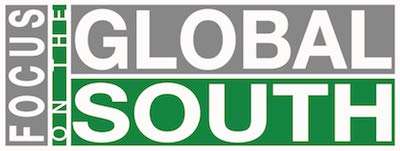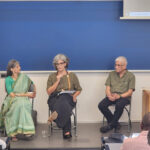By Aileen Kwa*
All the issues important to the US and the EU have been delivered in the WTO draft negotiating text released on 16 July by the chair of the General Council and due to be discussed at the General Council meeting of 27 July. However, the issues most important to developing countries remain as promises yet to be delivered. For example, the draft deals with sensitive products for the US/EU yet there are no details about the treatment of special products for developing countries. Similarly, the new “blue box”, where the US can hide all its Farm Bill subsidies, is endorsed in the text yet developing countries are being told to dismantle their state trading enterprises.
The draft provides the US and the EU the coverage to continue with their huge farm subsidies, yet continue to pry open developing countries’ markets. The EU provided US$79 billion in 2000/2001 and US $72 billion in 2001. (1) With this draft, the current distortions will be locked in.
In the following article Aileen Kwa analyses paragraph by paragraph the implications of the July text. The WTO text covers domestic support, export competition and market access, with no interlinkage between the commitments demanded in each “pillar” of the proposed framework. The chairman’s draft can be downloaded at http://www.wto.org/english/tratop_e/dda_e/draft_text_gc_dg_19july04_e.htm
DOMESTIC SUPPORT
Para 6. Bullets 1 and 2:
The special and differential treatment (S&D) component for developing countries is effectively endorsing S&D for developed countries. Even developing countries providing so-called “trade distorting” domestic supports, even if only at a fraction of what developed countries provide, would have to reduce these – just by smaller amounts and over a longer time frame.
Para 7-8. Overall Reduction: A Tiered Formula
The language here is misleading. It seems to suggest that overall supports will be brought down. However, the components making up this “overall reduction” are the aggregate measurement of support (AMS), de minimis and the Blue Box. The Green Box, which accounts for 70% of US overall domestic supports and 25% of the EU’s domestic supports are not part of this “overall reduction”.
Para 9-10. Final Bound Total AMS: A Tiered Formula
The capping or limit put on “product-specific” AMS is an element introduced by the developing countries. This is because in the recent years, AMS supports provided by the US have ballooned. Between 1995 and 2001, US product-specific support in rice, for example, increased from US$11.6 million to US$763 million. (2)
Capping and reduction from “their respective average levels during a historical basis” is cold comfort if the figures for the base have been inflated several thousand times.
In addition, Bullet 9.4 says that only “some” of these product-specific caps will be reduced. The most sensitive products for the US and EU may not be reduced.
Para 11-12 De Minimis
The de minimis was devised in the Uruguay Round to provide some leeway to countries to avail of a certain amount of ‘trade-distorting’ supports. Members were able to provide up to 10% of overall production amounts for developed countries and 20% for developing countries. (3)
The United States’ overall production levels are so high that even 10% of de minimis is a very significant amount. Up to $10 billion of supports have been declared under the de minimis. Developing countries therefore have been asking for a reduction in de minimis supports by the developed countries.
The current language however penalizes developing countries as well. This is unfair as 61 out of 71 developing countries in the Uruguay Round had indicated that they provided zero AMS support in the base period. Under the old Agreement on Agriculture, these 61 countries have not been allowed to provide AMS support beyond the 10% de minimis level. Now even they are asked to lower their de minimis level of support!
Para 13-15 Blue Box
A new Blue Box has been granted to the US to give it legal coverage for its counter-cyclical payments under the Farm Bill. The Farm Bill has programmes which target eight crops, all sensitive for developing countries – cotton, wheat, corn, soybeans, rice, barley, oats and sorghum. The Blue Box was a category of supports only for “production-limiting” programmes. Since 1996, this has been used by the EU but not the US. In the current draft, the US has expanded the Blue Box to include programmes which are not “production-limiting”, so that their counter-cyclical Farm Bill supports can avail of it.
Previous drafts of the agriculture framework have mentioned that there should be a cap of 5% of the value of production for the new Blue Box. A ‘cap’ set at this level would still allow the US to provide up to $10 billion a year of subsidies under this new category. This would completely compensate for any reductions US makes in the AMS or de minimis. (See Table 1.) The outcome will be nothing more than a box-shifting exercise.
TABLE 1: US DOMESTIC SUPPORT – BLUE BOX, AMS, DE MINIMIS (US$ BILLIONS)
Note that this table does not include US’ Green Box Supports – which make up the bulk of US domestic supports – up to US$50.5 billion
Existing Subsidies After Framework
Blue Box 0 10
AMS* 20 12-14
De Minimis** 10 5
Total 30 27-29
*Assuming that AMS is reduced by 30/40%-60%.
** Assuming that de minimis is reduced by 50%.
Para 16 Green Box
The draft does not call for any serious change in the use of the Green Box by way of a cap or limit on the currently unlimited Green Box category. The supports under the Green Box, so-called ‘non-trade distorting’ or ‘minimally trade distorting’ have been the biggest loophole in the Agreement on Agriculture and look set to continue being so.
Green Box payments amount to 70% of US’ overall domestic supports (about $50.5 billion) and 25% of EU’s domestic supports ($19.6 billion in 2000/1). A significant portion of payments under the Green Box are various forms of “decoupled” and direct payments given to producers. Since the CAP reform, this will also increasingly be the case of the EU. The argument by the US and EU are that decoupled payments are non or minimally trade-distorting since they are given to farmers regardless of whether or not they produce and regardless of prices. Analysis of the effects of these payments however show that they have increased production, since a certain level of income is guaranteed and this removes risk. The money is also used by farmers to invest in production. (4) In the US, decoupled payments substantially increased production acreage – from 225,000 to 725,000 acres. (5)
If the supports are genuinely non-trade distorting, production levels would remain the same even without them. The reality is that production in both US and EU would be devastated without decoupled supports. (6) For example, under the EU’s 2003 CAP reform, up to 75% of supports to France’s cereal farmers will be decoupled, 25% will be coupled. By combining decoupled with coupled payments, farmers will already have to incur the fixed costs to plant cereals in order to obtain the 25% coupled payments. This would greatly influence whether farmers work all or part of their land and what crops they choose to plant. (7) Whatever the name, the way in which support programmes have been combined points to the likelihood that in the EU the same amount of money will go to the same producers to grow the same crops. Recent models and analysis by the European Commission and others have shown that increased production in cereals and dairy are expected under decoupling. (8)
The concept that Green Box supports are non-trade distorting should be rejected by developing countries. Green Box supports should instead be termed as indirect export subsidies and be treated accordingly. (9)
EXPORT COMPETITION
Para 17-18
The EU’s promise to eliminate export subsidies is insincere. The key phrase is “parallel elimination of all forms of export subsidies and disciplines on all export measures with equivalent effect.” Others, principally the US, will have to make commitments to eliminate its export subsidization programmes before the EU moves.
Even more worrying is tying export subsidy elimination with the disciplining of State Trading Enterprises (STEs). Canada, Australia, New Zealand, and a large number of developing countries will be affected should the “monopoly powers” of the STEs be curtailed. (10) In developing countries, STEs play a central role in controlling exports and imports in order to control food supplies as well as prices. This is important for food security, stabilizing prices for consumers and incomes for farmers. By linking export subsidy elimination with STEs, developing countries will have to pay a disproportionately high price for elimination of EU dumping. In fact, given that STEs are institutions central to ensuring food security, their deregulation should not be a traded-off in the negotiations. In addition, STEs for developing countries are necessary to give small farmers in developing countries leverage vis-a-vis the agri-business corporations that control world agricultural trade.
Another escape clause for the EU is in paragraph 19 which states that phasing out export subsidies will “take into account the need for some coherence with internal reform steps of Members.” This could take a very long time. If the EU insists on that, developing countries should introduce the same language in the market access section.
Para 21 -23. Special and Differential Treatment
Developing countries provide a mere fraction of the export subsidies the developed countries do. It is therefore a slap in the face – under special and differential treatment (S&D) – to demand developing countries to also phase out their export subsidies.
MARKET ACCESS
Para 26-28 The Single Approach: A Tiered Formula
As with the other areas — domestic supports and export subsidies — the market access pillar is being dealt with on its own.
Developing countries should instead insist on real interlinkage between the pillars so that those bearing the brunt of US / EU trade distortions (measured by the overall level of domestic supports cum export subsidies) will not have to undertake tariff reductions until these distortions have been removed since tariffs are their principal means to defend themselves against dumping.
29-43. Sensitive Products (for developed countries) and Special and Differential Treatment (SP for developing countries)
No details are given on the coverage of special products for developing countries. At the same time, developed countries’ interests in protecting the full range of their sensitive products (using Tariff Rate Quotas, TRQs) have been given the green light.
In bilateral trade negotiations, the US and EU have been telling developing countries that there will have to be a limit on special products (the number floating around Geneva is five). In contrast, the EU enjoys a quota system (where lower tariff rates are applied to a limited quota and beyond this quota a much higher prohibitive tariff is charged) covering 87 of its sensitive products. These products can be broken down further into several tariff lines each.
The US has 54 TRQs, Norway 232, Japan 20 and Canada 21. Developing countries in contrast have much fewer TRQs and many have none at all. Some examples include Barbados 36, Philippines 14, Thailand 23, Indonesia 2, Dominican Republic 8, Nigeria 9.
They will therefore have recourse to protect fewer products. In addition, they are disadvantaged because paragraphs 34 and 35 calls for quota expansion for TRQs as well as tariff reductions. Since what is a TRQ is likely to coincide with what is a “special product” (SP) it may mean that even SP products have to undergo tariff reduction and quota expansion.
The SP group has been asking for self-selection of special products, and that these products should not be subject to tariff reduction. None of their requests have been granted and the text simply states that for SP and the Special Safeguard Mechanism (SSM), “the selection and treatment of sensitive products” will be subject to negotiations.
Implication for Market Access Formula
Extensive coverage of “sensitive products” for the EU will affect their position on the Tariff Reduction Formula to be agreed upon in the future negotiations. The EU has generally been on the side of developing countries in resisting an ambitious tariff cutting formula (eg a Swiss Formula that cuts high tariffs by larger amounts) because of its own sensitive products. Now that these are protected, the Eu will be more offensive in terms of a market access formula.
CONCLUSION
The US Farm Bill payments and EU expansion point to increased supports in these countries and the system for doing so is being put in place in the draft framework – via the untouched Green Box and new Blue Box.
This text does not form the basis of rectifying distortions in the current agreement on agriculture and the parallel distortions in the world market. Everything in the text – market access, domestic supports and export subsidies – ensures that the status quo for the developed countries continues. They will not have to undertake any real commitments. In domestic supports, they will undertake a box-shuffling exercise. In market access, a large number of sensitive products for the EU and US will continue to be protected. Nothing is given by way of SP and SSM to developing countries. The EU’s pre-condition that state trading enterprises (STE) be deregulated before it will eliminate export subsidies is potentially disastrous for developing countries and even some developed countries.
Dumping will continue and increase since developing countries tariffs and protection through STEs are targeted for removal.
Developing countries governments should insist on real interlinkages between the pillars. There should be no movement on their part in tariff reductions or the other pillars until those distorting the market rectify the situation, ie. until export subsidies – direct and indirect (Blue Box / Green Box, AMS) – are brought down to negligible levels. Failing this, there should be no agreement in July.
COTTON ANNEX A PARA 4
Countries asking for elimination of cotton subsidies are given empty promises that the issue will be addressed in the overall agriculture negotiations. This contravenes what the G90 Ministers in Mauritius (July) agreed upon – that cotton must be treated as a standalone issue. The clauses on cotton suffer from the same malaise that applies to the entire text on agriculture.
Empty Promise 1: There will be substantial reduction in product-specific supports which will be capped.
There is no guarantee that cotton will be one of these product-specific supports which will be reduced (para 9 bullet 4). Even if it is included, at what level will it be capped? US product-specific support in cotton increased from US$32 million to US$2.8 billion between 1996 – 2001. (11) If it is capped at the $2.8 billion level and then reduced, the subsidy would still be huge.
In addition, the reduced support would be moved to the Blue Box and Green Box.
Empty Promise 2: Substantial improvement in market access
Market access has never been the issue for the cotton countries. The West Africans are the most competitive in the world but they cannot produce because of depressed prices.
Empty Promise 3: Elimination of Export Subsidies and other Competition Instruments
As discussed above, the commitment on export subsidies is weak, due to “parallelism” and the clause pertaining to taking into account Members’ internal reform.
* Aileen Kwa is a policy analyst with Focus on the Global South. She has been monitoring WTO negotiations since 1995.
Notes:
1. Dhar B. 2004 “Trade Liberalisation and the Agricultural Sector: Experience of Developing Countries in Asia” forthcoming chapter in the Asia Trade and Human Development Report, UNDP.
2. Dhar B. 2004.
3. For developed countries, 5% of the de minimis is for product-specific supports and 5% for non-product specific supports. For developing countries is it 10% in each category.
4. AgraEurope, 2000. US ‘neutral’ subsidies influence production. 20th October, and OECD, 2001. “decoupling – a conceptual overview. http://222.oecd.org/dataoecd/23/51/25481500.pdf
5. ERS, 2000. US Farm Program Benefits. Economic Research Service / USDA, cited in Rice T. 2004, ‘5 Reasons why a comprehensive review of Green Box subsidies is required within the WTO’, Actionaid UK, June.
6. AgraEurope 2003. Lessons to be learnt from Cancun. 26th September 2003, cited in Rice T 2004.
7. See Rice T 2004.
8. Colman, D and Harvey, D. The Future of UK Diary Farming. http: //www.defra.gov.uk/foodrin/milk/colman-harveyreport.pdf and Analysis of the 2003 CAP Reform Agreement. FAPRI. http://www.fapri.missouri.edu/FAPRI_Publications.htm. See also Kwa A 2003 “EU’s CAP Reform: Let Us Not Be Fooled”, Focus on the Global South.
9. Rice T 2004.
10. Many developing countries have one if not more STEs for various commodities. Eg. Indonesia – Bulog; Philippines – National Food Authority; China – Cofco; Vietnam – Vietnamese Southern Food Cooperation; Malaysia – Bernas.
11. Dhar B. 2004.








